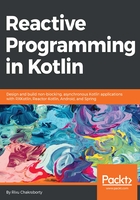
Applying functional programming to the ReactiveCalculator class
So, now, after trying to understand the ReactiveCalculator class from the previous chapter, we will try to optimize the code as well. Let's first take a look at the init block of the ReactiveCalculator class:
init{
nums = Pair(a,b)
subjectAdd.map({ it.first+it.second }).subscribe({println
("Add = $it")} )//1
subjectSub.map({ it.first-it.second }).subscribe({println
("Substract = $it")} )
subjectMult.map({ it.first*it.second }).subscribe
({println("Multiply = $it")} )
subjectDiv.map({ it.first/(it.second*1.0) }).subscribe
({println("Divide = $it")} )
subjectCalc.subscribe({
with(it) {
calculateAddition()
calculateSubstraction()
calculateMultiplication()
calculateDivision()
}
})
subjectCalc.onNext(this)
}
So, now, with the knowledge of functional programming, we can easily say that the map and subscribe methods are high-order functions that take function as parameter. However, do you really think that many subject and subscriber are required? Shouldn't subscriber on the class be sufficient to accomplish the job itself? Let's try to modify and optimize the following piece of code:
class ReactiveCalculator(a:Int, b:Int) {
val subjectCalc: io.reactivex.subjects.Subject
<ReactiveCalculator> =
io.reactivex.subjects.PublishSubject.create()
var nums:Pair<Int,Int> = Pair(0,0)
init{
nums = Pair(a,b)
subjectCalc.subscribe({
with(it) {
calculateAddition()
calculateSubstraction()
calculateMultiplication()
calculateDivision()
}
})
subjectCalc.onNext(this)
}
inline fun calculateAddition():Int {
val result = nums.first + nums.second
println("Add = $result")
return result
}
inline fun calculateSubstraction():Int {
val result = nums.first - nums.second
println("Substract = $result")
return result
}
inline fun calculateMultiplication():Int {
val result = nums.first * nums.second
println("Multiply = $result")
return result
}
inline fun calculateDivision():Double {
val result = (nums.first*1.0) / (nums.second*1.0)
println("Multiply = $result")
return result
}
inline fun modifyNumbers (a:Int = nums.first, b:
Int = nums.second) {
nums = Pair(a,b)
subjectCalc.onNext(this)
}
fun handleInput(inputLine:String?) {
if(!inputLine.equals("exit")) {
val pattern: java.util.regex.Pattern =
java.util.regex.Pattern.compile
("([a|b])(?:\\s)?=(?:\\s)?(\\d*)");
var a: Int? = null
var b: Int? = null
val matcher: java.util.regex.Matcher =
pattern.matcher(inputLine)
if (matcher.matches() && matcher.group(1) != null &&
matcher.group(2) != null) {
if(matcher.group(1).toLowerCase().equals("a")){
a = matcher.group(2).toInt()
} else if(matcher.group(1).toLowerCase().equals("b")){
b = matcher.group(2).toInt()
}
}
when {
a != null && b != null -> modifyNumbers(a, b)
a != null -> modifyNumbers(a = a)
b != null -> modifyNumbers(b = b)
else -> println("Invalid Input")
}
}
}
}
So, we have removed all other subscriber and are doing the job with only one. And here's the output:
Initial Output with a = 15, b = 10 Add = 25 Substract = 5 Multiply = 150 Multiply = 1.5 Enter a = <number> or b = <number> in separate lines exit to exit the program a = 6 Add = 16 Substract = -4 Multiply = 60 Multiply = 0.6 b=4 Add = 10 Substract = 2 Multiply = 24 Multiply = 1.5 exit
We subscribe to the class object itself; so, whenever its variables get changed, we get notified, and we perform all the tasks right there in the subscribe method. Moreover, as we have made the functions inline, they'll also help in the optimization of performance.